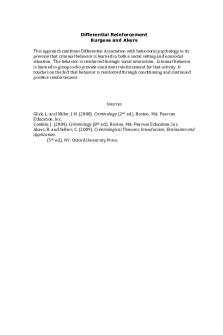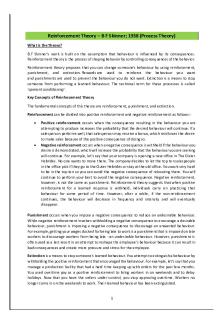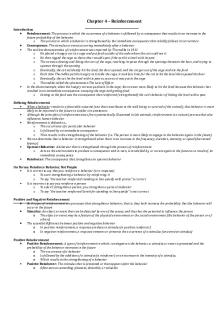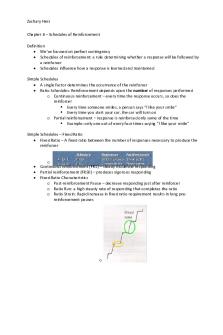Chapter 15 Differential Reinforcement PDF

| Title | Chapter 15 Differential Reinforcement |
|---|---|
| Course | Lab in Child Behavior |
| Institution | Binghamton University |
| Pages | 9 |
| File Size | 86.5 KB |
| File Type | |
| Total Downloads | 39 |
| Total Views | 143 |
Summary
Practice Questions ch15...
Description
1. Bobby’s Mom is trying to increase the number of times that Bobby shares his toys with his younger brother. When Bobby shares his toys, his Mom praises Bobby and plays with him, but when Bobby refuses to share his toys his Mom does not praise him or play with him. As a result, Bobby increases the number of times he shares his toys with his younger brother. This is an example of: a. DRO b. shapin g c. DRL d. DRA ANSWER: d 2. DRA involves using ____________ for desirable behaviors and ___________ for undesirable behaviors. a. reinforcement; extinction b. reinforcement; punishment c. extinction; reinforcement d. extinction; punishment ANSWER: a 3. Which of the following conditions is(are) necessary in order for DRA to be used? a. the goal is to increase desirable behavior b. you have access to a reinforcer you can use c. the behavior already occurs d. all of these ANSWER: d 4. Matthew frequently screams when he wants attention from his Mom. In order to decrease Matthew’s screaming behavior, his Mom does not pay attention to him when he screams. When Matthew quietly asks for attention, his behavior is reinforced with attention from his Mom. Which differential reinforcement procedure is Matthew’s Mom using? a. DRL b. DRO c. DRH d. DRA ANSWER: d 5. When using a DRA procedure, the alternative behavior must: a. be functionally equivalent to the problem behavior b. require more response effort than the problem behavior c. be reinforced on an intermittent reinforcement schedule d. A and C ANSWER: a 6. The amount of effort required to engage in the alternative behavior together with the schedule of reinforcement for the alternative behavior is referred to as: a. response cost b. response efficiency
c. an establishing operation d. a behavioral contingency ANSWER: b 7. Which type of differential reinforcement is most likely to lead to an increase in an alternative behavior? a. DRO b. DRL c. DRM d. DRA ANSWER: d 8. An individual with mental retardation frequently engages in aggressive behavior when he wants a break from a task at work. When he engages in aggressive behavior, he is required to continue working on the task, but if he asks for a break his behavior is reinforced with a break from the task. Which variation of DRA is being used in this example? a. DRL b. DRI c. DRO d. Functional communication training ANSWER: d 9. Mary frequently blurts out answers to questions without waiting to be called on because she likes attention from the teacher. When Mary raises her hand, the teacher calls on her, but when Mary blurts out an answer the teacher ignores her and calls on another student. As a result, Mary’s behavior of raising her hand increases, and her behavior of blurting out answers decreases. The teacher used ____________ for Mary’s behavior of raising her hand and ____________ for her behavior of blurting out answers. a. reinforcement ; extinction b. reinforcement ; punishment c. extinction ; punishment d. extinction ; reinforcement ANSWER: a 10. How can a reinforcer for an individual be identified? a. ask the individual b. observe the individual c. test potential reinforcers d. all of these ANSWER: d 11. In order for differential reinforcement to be most effective, the desirable behavior should be reinforced: a. immediately b. intermittently c. randomly d. A and B ANSWER: a
12. Julie’s parents used DRA at home in order to get Julie to increase her behavior of speaking clearly and reduce her behavior of mumbling. As a result, Julie now speaks clearly at home, at school, and at church. Julie’s behavior of speaking clearly is said to have ____________ to other relevant stimulus situations. a. expanded b. generalized c. transferred d. broadened ANSWER: b 13. When a desirable behavior results in escape or avoidance of an aversive stimulus, it is referred to as differential: a. negative reinforcement b. positive reinforcement c. negative punishment d. positive punishment ANSWER: a 14. Differential reinforcement of a low probability behavior with the opportunity to engage in a high probability behavior is referred to as: a. conditioning b. characteristics of the consequence c. an establishing operation d. the Premack principle ANSWER: d 15. The desirable and undesirable behaviors involved in differential reinforcement have schedules of reinforcement that exist at the same time. Behaviors that have reinforcement schedules existing at the same time are referred to as: a. concurrent operants b. overlapping behaviors c. simultaneous operants d. interfering behaviors ANSWER: a 16. Which of the following is NOT a type of differential reinforcement? a. DRO b. DRA c. DRL d. DRB ANSWER: d 17. A parent is trying to decrease a child’s swearing behavior. For every hour that the child goes without swearing, the parent reinforces the absence of swearing by reading to the child. If the child swears, the parent does not give the child attention and the child has to wait another hour for a story. Which differential reinforcement procedure is the parent using? a. DRA
b. DRL c. DRO d. DRI ANSWER: c 18. In order to implement DRO successfully you need to: a. deliver the reinforcer when the alternative behavior occurs b. deliver the reinforcer for the absence of the problem behavior c. deliver the punisher when the problem behavior occurs d. A and C ANSWER: b 19. Which of the following is NOT a strategy used in identifying the reinforcer to use in the DRO procedure? a. experimental manipulation of potential reinforcers b. observing individuals to determine their preferences c. selecting a stimulus that is reinforcing for most people d. choosing the reinforcer that is maintaining the problem behavior ANSWER: c 20. The initial time interval that is selected for the DRO procedure should be: a. one that is challenging for the individual to meet b. based on the baseline rate of the behavior c. long enough so that it does not have to be adjusted d. all of these ANSWER: b 21. At what point during the implementation of DRO is the time interval increased? a. when the problem behavior continues to occur at a high level b. when the reinforcer is being delivered after most intervals c. the time interval is not increased in DRO d. A and B ANSWER: b 22. What is the result if the problem behavior occurs during the DRO interval? a. the reinforcer is delivered b. the interval length is increased c. the interval for the reinforcer is reset d. B and C ANSWER: c 23. A teacher is trying to decrease a child’s screaming behavior. If the child does not scream for an entire 30-minute interval, the absence of screaming is reinforced with attention from the teacher. Which differential reinforcement
procedure is the teacher using? a. momentary DRO b. full-session DRL c. whole-interval DRO d. DRA ANSWER: c 24. In which DRO variation is the reinforcer delivered when the problem behavior is absent at the end of the interval? a. whole-interval DRO b. spaced-responding DRO c. partial DRO d. momentary DRO ANSWER: d 25. Which of the following will increase the effectiveness of DRO? a. delivering the reinforcer when the behavior is absent only at the end of the interval b. delivering the reinforcer when the behavior is absent for the entire interval c. selecting an initial interval length longer than the baseline rate of the behavior d. B and C ANSWER: b 26. Mary’s parents are trying to decrease the number of times that she feeds the family dog during the day. Mary’s parents set a criterion level for the maximum number of times that she can feed the dog in a day, and if Mary achieves this level she gets a story read to her at bedtime. Which type of differential reinforcement are Mary’s parents using? a. DRO b. DRA c. DRL d. DRC ANSWER: c 27. Nicole’s parents are trying to decrease the number of phone calls that she makes in a day. If Nicole makes fewer than 5 calls in a day, she is allowed to have a friend over the next day. In which DRL variation is the reinforcer delivered if the number of responses that occur in a period of time is less than a specified level. a. full-session DRL b. spaced-responding DRL c. whole-interval DRL d. response DRL ANSWER: a 28. Tommy is frequently asking his parents questions, and they want to decrease his behavior to an acceptable level. Tommy’s parents tell him that they will answer a question only if it has been at least 10 minutes since his last question. If Tommy asks a question before the 10-minute interval is up, his parents do not reinforce his behavior with an answer to the question? Which DRL variation are Tommy’s parents using? a. full-session DRL b. interval DRL
c. spaced-responding DRL d. secondary DRL ANSWER: c 29. How do the procedures of whole-interval DRO and spaced-responding DRL differ? a. DRO reinforces absence of behavior and DRL reinforces decreased rate of behavior b. DRO resets the interval if the behavior occurs but DRL does not c. DRO is used to decrease behavior and DRL is used to eliminate behavior d. A and B ANSWER: a 30. When you are most interested in decreasing the overall rate of a behavior you should use ____________ DRL, but if the timing of the behavior is most important you should use ____________ DRL. a. full-session; spacedresponding b. spaced-responding; fullsession c. response; delay d. whole-interval; momentary ANSWER: a 31. The two principles involved in DRA are ___________ and ___________. ANSWER: reinforcement, extinction 32. Three ways to identify an appropriate reinforcer are ___________, ___________, and ___________. ANSWER: ask, observe, test 33. To program for generalization with DRA, the ___________ should be differentially reinforced in as many relevant situations as possible and by as many relevant people as possible. ANSWER: alternative behavior 34. In a DRO procedure, the reinforcer is contingent on ___________. ANSWER: the absence of the problem behavior 35. When identifying a reinforcer to use in a DRO procedure, one consequence event that will function as a reinforcer for the person is ___________. ANSWER: reinforcer for the problem behavior 36. Sally is on a DRO 10 min. schedule for screaming. If after 5 min. Sally screams, what happens next? ______ ANSWER: the interval is reset
37. In the DRL procedure, you reinforce a(n) ___________ of the problem behavior. ANSWER: lower rate 38. Reinforcement delivered when fewer than a specified number of responses occurs in a period of time is referred to as ___________ DRL. ANSWER: full-session; full session 39. If you are trying to get a child with intellectual disability to drink his milk slower and you want 10 sec. to elapse between each gulp, then ___________ DRL is most appropriate. ANSWER: spaced responding 40. In a DRA procedure, when the alternative behavior results in the same reinforcer as the problem behavior, we say that the alternative behavior is ___________ to the problem behavior. ANSWER: functionally equivalent 41. The alternative behavior in a DRA procedure should require ___________ response effort than the problem behavior. ANSWER: les s 42. Identify the examples below as DRO, DRA, or DRL. ___________ Tony, a four year old boy, frequently squirmed in church and disrupted the people sitting near him. Dad decided to use differential reinforcement. When they first got to church, Dad told Tony if he didn’t squirm, he could earn stickers. Once church started, Dad gave Tony a sticker after every 10 minutes that he did not squirm. ___________ Mary was supposed to do her homework at the kitchen table in the evening. Frequently Mary talked to Mom while she was supposed to be studying. Mom usually talked to Mary for a few minutes each time Mary spoke to her. Mom decided on a plan to get Mary to talk less while studying. Whenever Mary was studying, Mom would praise her, but when Mary tried to talk to Mom, Mom would walk out of the room without responding to Mary. ___________ Claire, a woman with intellectual disability working in a workshop, got up and went to the bathroom 5 or 6 times each morning and 5 or 6 times each afternoon. She recently had a physical, so there was no medical problem. The supervisor implemented a program in which Claire earned a token if she went to the bathroom no more than 2 times in the morning and not more than 2 times in the afternoon. She later traded her tokens in for back-up reinforcers. ANSWER: DRO; DRA; DRL 43. DRA is an effective way to increase a desirable behavior. a. True b. Fals e ANSWER: True 44. It is not necessary to define both the desirable and the undesirable behaviors when using DRA a. True b. Fals e ANSWER: Fals e
45. The same reinforcers will be effective for most people. a. True b. Fals e ANSWER: Fals e 46. Utilizing the same reinforcer that is maintaining an undesirable behavior is an effective way to increase a desirable behavior. a. True b. Fals e ANSWER: True 47. Continuous reinforcement should be used throughout the process of using DRA. a. True b. Fals e ANSWER: Fals e 48. In the DRO procedure, you reinforce other behavior to take the place of the problem behavior you want to decrease. a. True b. Fals e ANSWER: Fals e 49. Extinction of the problem behavior is a component of the DRO procedure. a. True b. Fals e ANSWER: True 50. DRO intervals should be gradually shortened over time. a. True b. Fals e ANSWER: Fals e 51. Momentary DRO procedures are more effective than whole interval DRO procedures. a. True b. Fals e ANSWER: Fals e 52. In spaced responding DRL, the reinforcer is delivered for the absence of a behavior after a time interval has passed.
a. True b. Fals e ANSWER: Fals e 53. In a DRA procedure, starting with a continuous schedule of reinforcement for the alternative behavior works best. a. True b. Fals e ANSWER: True 54. What is the difference between spaced responding DRL and DRO? ANSWER DRO is used when you want to eliminate a problem behavior and spaced responding : DRL is used when you want to decrease the rate of a behavior that occurs too frequently. 55. What happens in a DRA procedure? ANSWER DRA is the application of reinforcement and extinction to increase the occurrence of a : desirable target behavior while decreasing the occurrence of behaviors that interfere with the target behavior. 56. What is the difference between a whole interval DRO procedure and a momentary DRO procedure? ANSWER In the whole interval DRO procedure, the problem behavior must be absent for the : whole interval for the reinforcer to be delivered. In momentary DRO, the problem behavior must be absent at the end of the interval for the reinforcer to be delivered. 57. Jeff is a boy with autism who grabs and squeezes his face when the teacher asks him to complete a task. The teacher allows Jeff to leave the room when this occurs because he will stop hurting himself. After 5 minutes, Jeff usually returns to the classroom and completes at least some of the requested task. Describe how you would implement a DRA procedure to increase Jeff’s completing schoolwork and decrease his self injurious behavior. ANSWER I would teach Jeff to ask for a break. Then whenever Jeff asks for a break, his asking : will be reinforced by being allowed to leave the room and take a break. If however, Jeff squeezes his face, he would not be allowed to leave the room and take a break. 58. Provide an example of full session DRL. ANSWER An example of full session DRL is if Jacob raises his hand no more than 3 times per : class period, the teacher calls on him as a reinforcer. Note that Jacob can raise his hand 3 times at any point in the interval and still be called on, as long as he does not raise his hand more than 3 times. 59. Provide an example of DRO. ANSWER An example of DRO is Aimee is given a sticker as a reinforcer at the end of every ten : minutes in which she does not talk out in class....
Similar Free PDFs

Differential reinforcement
- 4 Pages

Differential Reinforcement
- 1 Pages

Chapter-15 - chapter 15
- 18 Pages

Chapter 25-Differential An
- 96 Pages

Reinforcement-Theory
- 2 Pages

Chapter 15
- 73 Pages

Chapter 15
- 21 Pages

Chapter 15
- 34 Pages

Chapter 15
- 11 Pages

Chapter 15
- 27 Pages
Popular Institutions
- Tinajero National High School - Annex
- Politeknik Caltex Riau
- Yokohama City University
- SGT University
- University of Al-Qadisiyah
- Divine Word College of Vigan
- Techniek College Rotterdam
- Universidade de Santiago
- Universiti Teknologi MARA Cawangan Johor Kampus Pasir Gudang
- Poltekkes Kemenkes Yogyakarta
- Baguio City National High School
- Colegio san marcos
- preparatoria uno
- Centro de Bachillerato Tecnológico Industrial y de Servicios No. 107
- Dalian Maritime University
- Quang Trung Secondary School
- Colegio Tecnológico en Informática
- Corporación Regional de Educación Superior
- Grupo CEDVA
- Dar Al Uloom University
- Centro de Estudios Preuniversitarios de la Universidad Nacional de Ingeniería
- 上智大学
- Aakash International School, Nuna Majara
- San Felipe Neri Catholic School
- Kang Chiao International School - New Taipei City
- Misamis Occidental National High School
- Institución Educativa Escuela Normal Juan Ladrilleros
- Kolehiyo ng Pantukan
- Batanes State College
- Instituto Continental
- Sekolah Menengah Kejuruan Kesehatan Kaltara (Tarakan)
- Colegio de La Inmaculada Concepcion - Cebu





